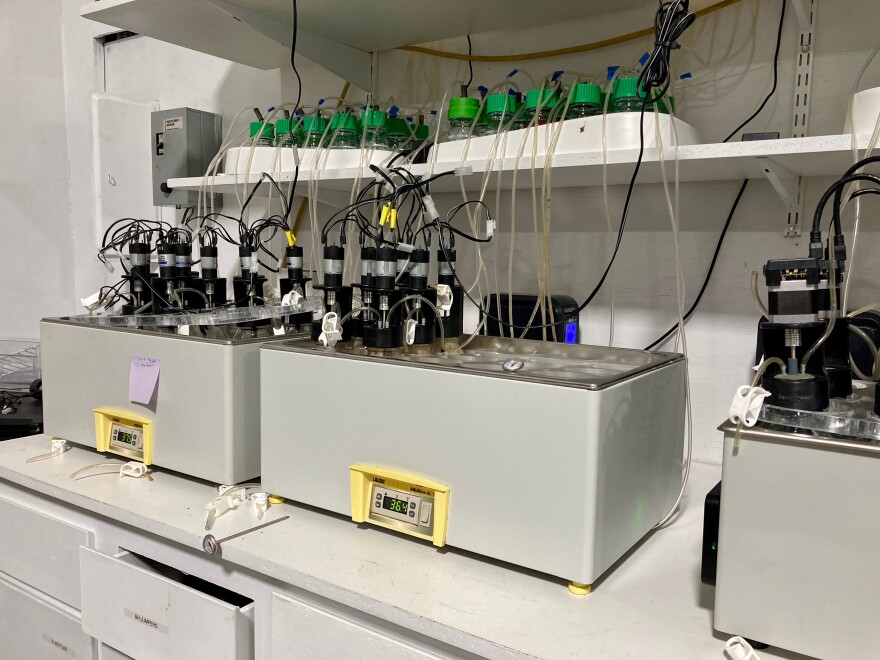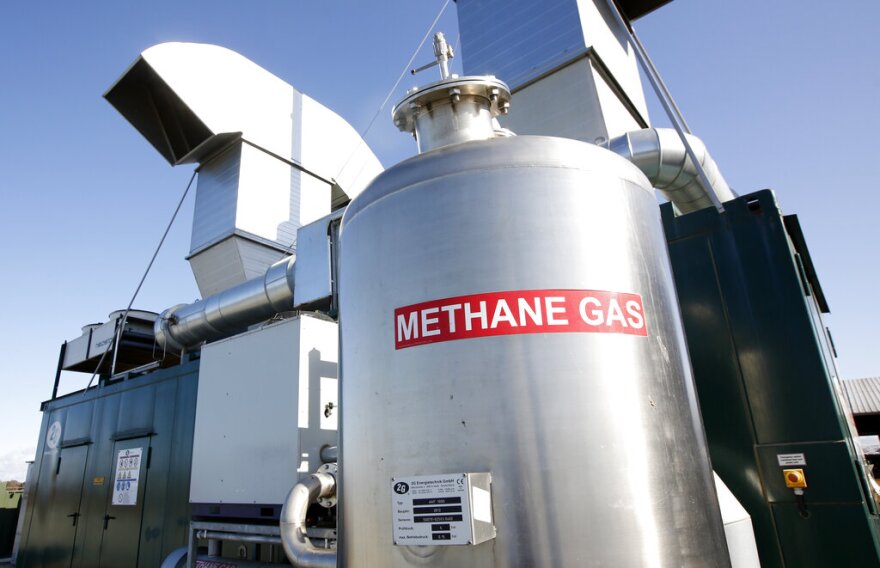In an industrial laboratory in Boise, small white bins hold immersion blender-like devices that churn cow manure.
"This is basically where most of the laboratory function happens," said Will Charlton.
He's the president of Digester Doc, a company that helps farms get more energy out of their cow manure. Charlton is the "doc" himself.
"We put organic material – manure, or whatever else – into these 500 mL bottles," he said, pointing to the churning devices. "As the gas comes up, and it produces gas, it will basically lift one of these paddles."
Charlton blew into a tube to simulate the process and scooted over to a computer where the movement was documented on a chart.
This Rube Goldberg-like sequence replicates a process called anaerobic digestion. That's when bacteria breaks down organic matter and creates biogas in the process.

Dairy farms use anaerobic digestion to break down cow manure, one of the biggest sources of anthropogenic methane emissions. Methane is one of the most potent greenhouse gasses.
On dairy farms, digesters look like big plastic tarps covering manure pits or large cylindrical tanks. Instead of going into the atmosphere, the methane gas is captured and channeled into a pipeline. The U.S. Environmental Protection Agency estimates dairy farms that have digesters can reduce their methane emissions by 85% a year.
At the Digester Doc laboratory in Boise, Charlton measures exactly how much gas can be extracted from a given farm's waste sample, which he receives in small glass vials, and how much time it takes to produce the gas.
"Whether it's 17 days, 21 days or 25 days has a big impact on the costs of an anaerobic digester system," he said.
Charlton has been working on the biochemical side of digestion for more than 20 years but says he's never seen so much interest in the market as he does now.
"It's a gold rush," he said.

A big reason for that is a carbon credit system in California called the Low Carbon Fuel Standard, or LCFS. Its goal is to reduce the carbon footprint of the state's transportation sector by 20% by 2030.
Oil and gas companies can buy the carbon offsets from dairy farms that produce biogas.
LCFS has been around for more than ten years, but the profit incentives for dairy farms have only ramped up recently. And by selling the environmental attributes of the biogas, farmers can get around five times as much money per energy unit as they can from selling just the gas, according to Charlton.
Previously, farmers viewed digesters as a risky proposition.
Rick Naerebout, the CEO of the Idaho Dairymen's Association, pointed to an announcement in 2019 by a North Carolina company, GESS International, that said it wanted to invest more than $200 million to build six anaerobic digesters in the Burley area. Farmers put up their own funds to participate, Naerebout said, only for the company to back out.
"That's where the industry has been apprehensive of these type projects in the past because the economics just didn't make sense," he said.
Fewer than three years later, Naerebout said the market has changed — for the better. Now, many farmers are being approached to install digesters by out-of-state developers, gas companies, and even venture capital firms every week.
For, Peter Kasper, a farmer whose family has dairy farms in Kuna and Melba, it began with conversations with other local dairy farmers.
"That kind of got us to the point where we were like we need to explore this, we need to see what can be done," he said.
In Kuna, the farm is pairing with neighboring dairies to construct a digester that will capture the combined manure. It's looking at installing one in Melba, too, and partnering with Digester Doc to do a feasibility study in order to assess the energy production potential.
"We see it as being able to create another side business, essentially, but it's vertical integration inside of what we're already doing," Kasper said.
That is, the farm will sell methane gas from the manure its cows are already producing. And to the California LCFS market, it can sell the environmental benefit of capturing some of the methane.
But Kasper has still been skeptical along the way. He said, for one, digesters are a big capital investment, costing between $4 and $8 million.
Also, he said, the major benefits farmers currently get from California's carbon credit system could change.
"Someone could get elected this year and just decide to change everything with the snap of their fingers, and just say well, we're not going to support this market anymore. And overnight all these digesters could just become unprofitable and they'd just be shut down," he said.

In fact, several environmental groups petitioned California Air Resources Board last fall to eliminate large farms' biogas from the LCFS program because they said the incentives those farms receive exaggerate the climate benefits of methane produced by their digesters.
"The monetization of that pollution is a major concern for us because we advocate for the more sustainable, less harmful models of animal agriculture," said Tyler Lobdell, who works for one of those environmental groups, Food and Water Watch, as a lawyer in Boise.
The group also said digesters incentivize big farms to expand, because currently, digesters only make economic sense if you have more than 3,000 cows in one place, according to a study by researchers at the Idaho National Laboratory.
Late last month, California rejected the environmental groups' plea to take a look at the issue immediately. Still, it will consider the arguments as part of its rule-making process next year.
Other environmental groups, like the Idaho Conservation League, are more supportive of digesters.
"Methane is huge," said Aly Bean, a climate coordinator with the organization. She said if the dairy industry wants to reach greenhouse gas neutrality by 2050, it has to start taking action somewhere.
ICL also said there's lots of opportunity in Idaho to capture methane that would otherwise be released into the environment.
Only about 10 digesters have been constructed in the state in the past 15 years. Charlton, the digester 'doc,' said that number could triple in the next five years.
In fact, according to the EPA, Idaho has the highest energy generation potential from dairy digester methane out of any state except California, in part because of the number of large farms.
One major project was announced last fall: Shell Oil is constructing a digester on a 10,000-cow dairy in Gooding.
"We expect there to be a number of these projects put on the ground over the next few years," said Naerebout.
He said, as other states, and potentially the federal government, follow California's lead and look to reduce climate impacts, there will likely be opportunities for more Idaho dairy farms to cash in on cow manure.
Correction: This story originally said the dairy farm in Gooding has 20,000 cows.
Find reporter Rachel Cohen on Twitter @racheld_cohen
Copyright 2022 Boise State Public Radio



